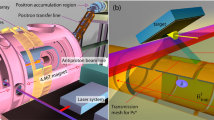Abstract
The problem of possible controlling the antihydrogen formation and deexcitation has become an actual one for the investigation of efficient methodologies for the production of cold antihydrogen in the ground state. In 1983–1997 it was suggested and discussed by A. Wolf the possibility of laser-stimulated formation and stabilization of antihydrogen in collisions of antiprotons with positrons. In the present report we analyze the question with a wave-packet propagation method developed for the quantum two-body problem with a non-separable interaction. This computational technique can also be applied for analyzing the laser-assisted antihydrogen formation in magnetic traps.
Similar content being viewed by others
References
Neumann, R., Poth, H., Winnacker, A., Wolf, A.: Laser-enhanced electron-ion capture and antihydrogen formation. Z. Phys. A313, 253–262 (1983)
Wolf, A.: Laser-stimulated formation and stabilization of antihydrogen atoms. Hyperfine Interact. 76, 189–201 (1993)
Müller, A., Wolf, A.: Production of antihydrogen by recombination of p with e + : what can we learn from electron-ion collision studies? Hyperfine Interact. 109, 233–267 (1997)
Schramm, U., Berger, J., Grieser, M., Habs, D., Jaeschke, E., Kilgus, G., Schwalm, D., Wolf, A., Neumann, R., Schuch, R.: Observation of laser-induced recombination in merged electron and proton beams. Phys. Rev. Lett. 67, 22–25 (1991)
Yousif, F.B., Van der Donk, P., Kucherovsky, Z., Reis, J., Brannen, E., Mitchell, J.B.A., Morgan, T.J.: Experimental observation of laser-stimulated radiative recombination. Phys. Rev. Lett. 67, 26–29 (1991)
Amoretti, M., et al.: Search for laser-induced formation of antihydrogen atoms. Phys. Rev. Lett. 97, 213401-1-4 (2006)
Melezhik, V.S.: New approach to the old problem of muon sticking in μCF. Hyperfine Interact. 101/102, 365–374 (1996)
Melezhik, V.S.: Polarization of harmonics generated from a hydrogen atom in a strong laser field. Phys. Lett. A230, 203–208 (1997)
Melezhik, V.S., Baye, D.: Nonperturbative time-dependent approach to breakup of halo nuclei. Phys. Rev. C59, 3232–3239 (1999)
Melezhik, V.S., Schmelcher, P.: Quantum energy flow in atomic ions moving in magnetic fields. Phys. Rev. Lett. 84, 1870–1873 (2000)
Melezhik, V.S.: Recent progress in treatment of sticking and stripping with time-dependent approach. Hyperfine Interact. 138, 351–357 (2001)
Melezhik, V.S., Cohen, J.S., Chi-Yu H.: Stripping and excitation in collisions between p and He (n ≤ 3) calculated by a quantum time-dependent approach with semiclassical trajectories. Phys. Rev. A69, 032709-1-13 (2004)
Kim, J.I., Melezhik, V.S., Schmelcher, P.: Suppression of quantum scattering in strongly confined systems. Phys. Rev. Lett. 97, 193203-1-4 (2006)
Melezhik, V.S., Kim, J.I., Schmelcher, P.: Wave-packet dynamical analysis of ultracold scattering in cylindrical waveguides. Phys. Rev. A76, 053611-1-15 (2007)
Author information
Authors and Affiliations
Corresponding author
Rights and permissions
About this article
Cite this article
Melezhik, V.S. Perspectives of laser-stimulated antihydrogen formation. Hyperfine Interact 193, 329–334 (2009). https://doi.org/10.1007/s10751-009-0019-4
Published:
Issue Date:
DOI: https://doi.org/10.1007/s10751-009-0019-4




